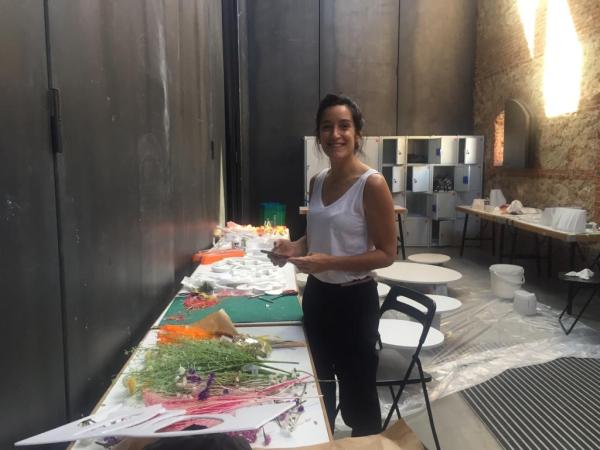Q&A with Nerea Feliz, Interior Design Associate Professor

Situated at the intersection of architecture, interior design, and interior urbanism, Associate Professor Nerea Feliz’s work explores interior design’s role as a mediator between us, the public spaces we occupy, and pressing cultural and political questions. Feliz received her Master’s and her Bachelor’s in Architecture from the Politecnica University of Madrid, Escuela Técnica Superior de Arquitectura. Before joining the UT School of Architecture, she taught for four years at the University at Buffalo’s School of Architecture and Planning. Prior to moving to the U.S., Feliz worked for Foster & Partners and Zaha Hadid Architects, among others. She is a registered architect in Spain and the UK and started her own independent practice in 2010.
At the School of Architecture, Feliz teaches Interiors & Society, Inside Utopia, and design studios at the graduate and undergraduate levels. She is a member of the Society of Teaching Excellence at The University of Texas at Austin, was awarded the School of Architecture’s Outstanding Teaching Award for studio instruction in 2019, and 2020 Teaching Excellence Award from the Interior Design Educators Council.
You have a background in architecture. How did you come to focus on interior design and interior spaces?
I have always had an interest in interior spaces, but it was my experience working at Zaha Hadid Architects for two years that solidified love for interior design. The design culture at ZHA was, and I think still is, in Mark Wigley’s terms, both “implosive” and “explosive” according to his 1998 article “Whatever Happened to Total Design.” It was implosive in that buildings and interior spaces were designed to the smallest detail in search of the “total work of art,” and explosive because the architect designs everything, including outside of disciplinary boundaries. ZHA has designed shoes, cars, and the master plan of cities. During my time at ZHA, I had the great opportunity to be in charge of the interior design of the auditorium, the foyer, and the lobby of the CMA CGM Headquarters in Marseille. Aside from designing the layout of these spaces, I got to design furniture, light fixtures, railings, tiles, and every single aspect of the space. This experience shaped the future of my professional career.
Some of your work and research focuses on biodiversity, tell us a bit about that focus and your push to foster inclusivity of non-human species via design
Interior design, as a time-specific communication device, can help amplify current discourse on sustainability. Climate change as a challenge is not just scientific, but also cultural and political. When it comes to sustainability within architecture’s disciplinary sphere, the most common concerns and efforts focus on: 1) using renewable energy and resources and, 2) limiting energy consumption through a greater understanding of materials’ embodied energy, construction methods, and reducing a building’s operational carbon footprint. In the face of an incoming biodiversity crisis, design disciplines linked to the built environment –which have traditionally exhibited an exclusively anthropocentric focus—are also becoming increasingly aware of the need to actively engage in protecting biodiversity in urban environments. Interior designers can also take a proactive stance towards biodiversity. This is something I wrote about in a recent article for Interiority Journal. Over the past few years, I have also had the chance to work closely with Joyce Hwang, a leading scholar on designing for co-habitation with a range of non-human species. Together, we I have worked on several design projects that sought to bring attention to the endangerment of pollinators, like “City Creatures,” my proposal for the 2019 MoMA PS1 summer pavilion, the project “Hidden in Plain Sight,” or the “Bug Filter” studio I taught in Spring 2020.
In your opinion, what are some of the most important topics or areas of interior design discourse today?
I believe COVID-19 has made manifest the important role that interior design plays in shaping the quality of the spaces we occupy both at a physiological and a social level, as a mediator between us and the spaces we inhabit. As a scholarly discipline, interior design is fairly new, its discourse is still in the making, and even the definition of the discipline is still in the works. Personally, I understand interior design as the material expression of social and cultural values. So, on one hand, there are important issues related to materialization including the application of new technologies, fabrication, sustainable choice of materials, carbon footprint, labor practices, etc. But, at the same time, interior design shares contemporary societal concerns such as sustainability, social justice, accessibility, economic inequality, well-being, etc.
What are you currently working on or excited about, either here at UTSOA or in your own practice?
My work is a combination of scholarly writings and design projects with a sustained focus on public interiority. Like most faculty, I tend to work on several projects at different speeds. I am currently working on historic research to learn about the interior of the legendary Continental Baths in the Ansonia building in New York City. It is a fascinating story about interior design during the early stages of the disco movement and bathhouses as safe spaces for the gay community. Regarding creative work, I just had a wonderful experience working in collaboration with Clay Odom, Kory Bieg, and Igor Siddiqui on a design proposal that will be exhibited in the upcoming Tallinn Architecture Biennale TAB2022. At the moment, I am producing new work for a collective exhibition titled “On the Inside with You” that will take place in Chicago’s Space p11 gallery this winter, stay tuned!

